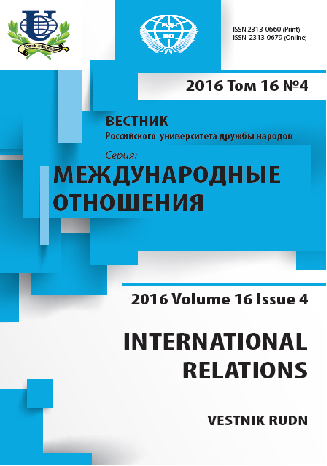India and The Arab World
- Authors: Lounev S.I.1
-
Affiliations:
- Moscow State Institute of International Relations (MGIMO-University), Ministry of Foreign Affairs of the Russian Federation
- Issue: Vol 16, No 4 (2016): Iran and India in the System of International Relations
- Pages: 603-615
- Section: Articles
- URL: https://journals.rudn.ru/international-relations/article/view/15435
- DOI: https://doi.org/10.22363/2313-0660-2016-16-4-603-615
Cite item
Full Text
Abstract
The article shows that Indian-Arab relations are very complex and are affected by many positive and negative factors. From a political point of view, the Middle East does not rank high in the priorities of India’s modern foreign policy. In the bipolar period, India tried to strengthen ties with all developing countries with the aim of becoming a leader of the South. In this respect, the region (especially Egypt in the 1950-1970s) played a special role. Now India pays attention mainly to vital actors. Policy of non-interference in regional conflicts is typical for India. Delhi has focused on the developing of ties with the countries of the Persian Gulf, due mainly to economic reasons that are of primary importance to India. This subregion is a major supplier of hydrocarbons to India, that is extremely vital for further rapid economic growth of the country (oil and gas account for about a third of India’s imports). In addition to this, millions of Indian citizens live in the Persian Gulf, and India (due to them) has become the world leader by the volume of migrant remittances. The largest semi-peripheral countries, among which India should be mentioned particularly, began to play a special role in the new world system. However, the politics of balancing is characteristic for India both on global level as well as on regional one. But a real great power (and the desire to obtain such high status was always the main goal for an Asian giant) should demonstrate a clear vision of global and regional issues, play an active role and offer its own solution of different conflicts and contradictions.
About the authors
Sergey Ivanovich Lounev
Moscow State Institute of International Relations (MGIMO-University), Ministry of Foreign Affairs of the Russian Federation
Author for correspondence.
Email: silounev@gmail.com
Moscow, Russia
References
- Baral, J.K., Mahanty, J.N. (1992). India and the Gulf Crisis: The Response of a Minority Government. Pacific Affairs, 65(3), pp. 368-84.
- Chaudhuri, R. (2014). Forged in Crisis. India and the United States since 1947. Delhi: HarperCollins Publishers.
- Chellaney, B. (2006). Asian Juggernaut. The Rise of China, India and Japan. New Delhi: HarperCollins Publishers.
- Cohen, S.P. (1990). Solving Proliferation Problems in a Regional Context: South Asia. New Threats. Responding to the Proliferation of Nuclear, Chemical, and Delivery Capabilities in the Third World. Aspen Strategy Group Reports. Lanham, Md.: University Press of America, pp. 153-177.
- Fabian, K.P. (2011). Oral History: Biggest Ever Air Evacuation in History. Indian Foreign Affairs Journal, 17 (1), pp. 93-107.
- Hiremath, J.R. (1997). India and the Overseas Indians. Indian Foreign Policy. Agenda for the 21st Century. Ed. by Mansingh L. New Delhi: Foreign Service Institute in association with Konark Publishers, 1, pp. 365–394.
- Jihadis in Jammu and Kashmir. (2003). A Portrait Gallery (Santhanam K., Sreedhar, Saxena S., Manish). New Delhi: Sage Publications.
- Joshi, Sh. (2015). India and the Middle East. Royal Society for Asian Affairs Asian Affairs, XLVI (II), pp. 251–269.
- Kapila, S. (2016). India’s Foreign Policy Challenges in the Middle East 2016. South Asia Analysis Group. Ghaziabad. Paper N. 6088.
- Nonalignment 2.0: A Foreign and Strategic Policy for India in the Twenty First Century. (2014). (Khilnani S., Kumar R., Mehta P.B., Menon P., Nilekani N., Raghavan S., Saran S., Varadarajan S.). New Delhi: Penguin Publications.
- Pakistan and Asian Peace. (1985). Ed. by Chopra V. D. New Delhi: Patriot Publishers.
- Pant, H.V. (2013). India and the Middle East: A Re-Assessment of Priorities? Indian Foreign Policy in a Unipolar World. Ed. by Pant H.V. New Delhi: Routledge, pp. 251-276.
- Pradhan, P.K. (2011). GCC-Iran Rivalry and Strategic Challenges for India in the Gulf. Indian Foreign Affairs Journal, 6(1), pp. 45-57.
- Pradhan, S. (2009). India's Economic and Political Presence in the Gulf: A Gulf Perspective. India's Growing Role in the Gulf. Dubai, UAE: Gulf Research Center, pp. 15-39.
- Rajan, S.I., Narayana, D. (2010). The financial crisis in the Gulf and its impact on South Asian migrant workers. Kerala: Centre for Development Studies. Working paper No 436.
- Rehman, I. (2012). India’s Aspirational Naval Doctrine. The Rise of the Indian Navy: Internal Vulnerabilities, External Challenges. Ed. by Pant H.V. Farnham: Asghgate, pp. 55–79.
- Singh, D., Chhabra, N. (2015). Trends in Gulf Demographics and Labour Migration (focus on Bahrain). New Delhi: A Federation of Indian Chambers of Commerce and Industry.
- The United States, India, and the Gulf: Convergence and Divergence in a Post-Iraq World? (2007). MIT Persian Gulf Initiative Workshop Report. Cambridge, MA: MIT Center for International Studies.











